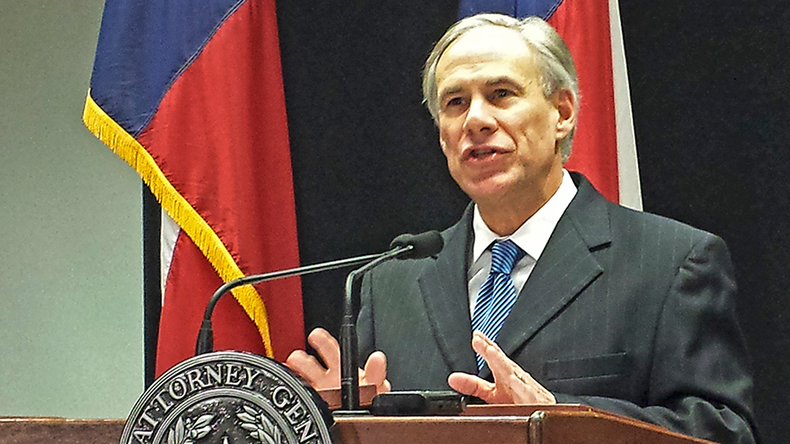Texas governor calls for states to amend Constitution, offers 9 amendments

Washington, DC will “take the Constitution seriously again,” Texas Governor Greg Abbott said at an annual meeting of the Texas Public Policy Foundation, where he presented nine constitutional amendments to be adopted by a convention of states.
“We have to take the lead to restore the rule of law in America,” Abbott told the large crowd in his keynote address of the Policy Orientation 2016 event.
It’s not an usual line to hear in a particularly political year, but in this case, the vehicle Abbott endorsed for amending the US Constitution is quite unusual. While the Constitution has been amended 27 times in its history, each and every time involved the same process: when two-thirds of both federal legislative bodies agree to amend. But the Constitution offers another method to add amendments.
Texas sues State Department to block Syrian refugee resettlement https://t.co/wXq8s9E692pic.twitter.com/84CfZgERmA
— RT America (@RT_America) December 3, 2015Abbott supported, to the standing ovation of the audience, what is often called an Article V convention, or convention of the states. Under the fifth article of the Constitution, it is referred to as a “convention for proposing amendments.” Two-thirds of the state legislatures would call such a convention, then the process requires three-fourths of state legislatures to ratify the proposed amendments.
Stressing the importance of the Tenth Amendment to the Constitution, which separates the powers delegated to the federal government from the powers maintained by the states and the people, Abbott accused President Obama, Congress, and the Supreme Court of having “run amok.”
“The irony for our generation is that the threat to our republic doesn’t come just from foreign enemies. It comes, in part, from our very own leaders,” Abbott said.
“The cure to these problems will not come from Washington, DC. They must come from the states,” he added. "Where is it that you enforce the Tenth Amendment?"
The question of enforcing the Tenth Amendment is a controversial one. In 1963, Alabama Governor George Wallace claimed authority to nullify federal laws ending racial segregation. State nullification, though, was first outlined by Thomas Jefferson and James Madison in their respective resolutions for Kentucky and Virginia in 1798. Later the doctrine was used to block federal enforcement of the Fugitive Slave Act.
Gun rights over gun control? Majority of Americans staunchly prefer Second Amendment [VIDEO] http://t.co/nS9VuazGOYpic.twitter.com/zM4sLkrfd0
— RT America (@RT_America) April 16, 2015Accompanying the rise of Tea Party activists in recent years has been a resurgence of the nullification doctrine, as well as Article V convention of the states, to push back on the growth of federal influence often seen as unconstitutional by supporters of states’ rights. The two strategies have been promoted as complementary by some, but activists have also quarreled over which is truly workable.
Abbott described the states’ abilities to enforce the Tenth Amendment as "hamstrung" by the three branches of the federal government, requiring new Constitutional amendments to restore balance to power. Abbott presented nine. Here they are in brief summary from Abbott’s “Restoring the Rule of Law With States Leading the Way” report:
• Prohibit Congress from regulating activity that occurs wholly within one state.
• Require Congress to balance its budget.
• Prohibit administrative agencies from creating federal law.
• Prohibit administrative agencies from pre-empting state law.
• Allow a two-thirds majority of the states to override a US Supreme Court decision.
• Require a seven-justice super-majority vote for US Supreme Court decisions that invalidate a democratically enacted law
• Restore the balance of power between the federal and state governments by limiting the former to the powers expressly delegated to it in the Constitution.
• Give state officials the power to sue in federal court when federal officials overstep their bounds.
• Allow a two-thirds majority of the states to override a federal law or regulation.
Freedom of speech? Prank petition to repeal First Amendment gets support at Yale [VIDEO] https://t.co/JdBQ2kwc9Zpic.twitter.com/tewhLqWBw5
— RT America (@RT_America) December 29, 2015The general notion of an Article V convention has received encouragement from prominent Republicans, both because of its recent rise in popularity and the fact that the GOP holds a majority of the country’s state legislatures and governorships. Presidential candidates Senator Marco Rubio (R-Florida), Senator Ted Cruz (R-Texas), and Senator Rand Paul (R-Kentucky) have expressed some level of support.
Liberals have also expressed interest in an Article V convention. Among issues popular on that side are overturning the Supreme Court’s Citizens United decision recognizing corporate personhood.












